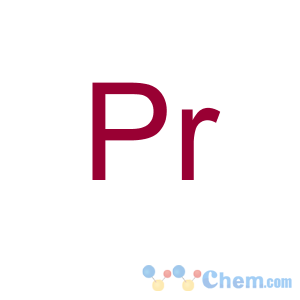Title: Praseodymium
CAS Registry Number: 7440-10-0
Literature References: Pr; at. wt 140.90765; at. no. 59; valences 3, 4. A lanthanide; belongs to the cerium group of rare earth metals. Naturally occurring isotope (mass number): 141; known artificial radioactive isotopes: 126, 129-140; 142-152. Prepn of radioactive isotopes by bombardment: Seaborg,
Chem. Rev. 27, 199 (1940); Huber
et al., Helv. Phys. Acta 18, 221 (1945). Abundance in earth's crust 5.5-9.1 ppm; found in rare earth minerals. Reported in 1843 by Mosander as
didymium which was a mixture of Pr and Nd; separated in 1885 by von Welsbach. Separated from other rare earth elements by fractional crystn. Also by ion exchange: Spedding
et al., J. Am. Chem. Soc. 69, 2786, 2812 (1947). Prepn of metal by electrolysis: Muthmann, Weiss,
Ann. 331, 1 (1904); Canneri, Rossi,
Gazz. Chim. Ital. 62, 1160 (1932); Mazza,
Atti X Congr. Int. Chim. 3, 604 (1939); Trombe, Mahn,
Compt. Rend. 220, 778 (1945). Toxicity study: Haley
et al., Toxicol. Appl. Pharmacol. 6, 614 (1964). Reviews of prepn, properties and compds:
The Rare Earths, F. H. Spedding, A. H. Daane, Eds. (Krieger, Huntington, N.Y., 1971, reprint of 1961 ed.) 641 pp; Hulet, Bode, "Separation Chemistry of the Lanthanides and Transplutonium Actinides" in
MTP Int. Rev. Sci.: Inorg. Chem., Ser. One Vol. 7, K. W. Bagnall, Ed. (Univ. Park Press, Baltimore, 1972) pp 1-45; Moeller, "The Lanthanides",
Comprehensive Inorganic Chemistry Vol. 4, J. C. Bailar, Jr.
et al., Eds. (Pergamon Press, Oxford, 1973) pp 1-101; F. H. Spedding in
Kirk-Othmer Encyclopedia of Chemical Technology vol. 19 (John Wiley & Sons, New York, 3rd ed., 1982) pp 833-854;
Chemistry of the Elements, N. N. Greenwood, A. Earnshaw, Eds. (Pergamon Press, New York, 1984) pp 1423-1449. Brief review of properties: G. T. Seaborg,
Radiochim. Acta 61, 115-122 (1993).
Properties: Yellowish metal, forms oxide film on exposure to moist air. Two crystalline forms: hexagonal a-form, d 6.475, transforms to b-form at 798°; body-centered cubic b-form, d 6.64, exists at >798°. mp 935°. bp 3020°; also reported as bp 3520° (Spedding). E0 (aq) Pr3+/Pr -2.47 V (calc). Experimental reduction potentials (referred to a normal calomel electrode): -1.875, -1.990 V: Noddack, Brukl,
Angew. Chem. 50, 362 (1937). Heat of sublimation (25°): 355.6 kJ/mol. Heat of fusion: 6.912 kJ/mol (Spedding, 1982). Also reported as heat of fusion: 11.3 ±2.1 kJ/mol (Greenwood, Earnshaw).
Melting point: mp 935°
Boiling point: bp 3020°; bp 3520° (Spedding)
Density: d 6.475; d 6.64
Derivative Type: Oxide
Molecular Formula: Pr2O3
Molecular Weight: 329.81
Percent Composition: Pr 85.45%, O 14.55%
Properties: d 7.07, prepd by reducing with hydrogen the oxides PrO2 or Pr6O11. Oxidizes to Pr6O11 on heating in air; forms the dioxide, PrO2, on fusing with potassium chlorate.
Density: d 7.07
Derivative Type: Hydroxide
Molecular Formula: Pr(OH)3
Molecular Weight: 191.93
Percent Composition: Pr 73.42%, O 25.01%, H 1.58%
Properties: A gelatinous pale green precipitate, obtained by the action of alkali hydroxide on a soln of a praseodymium salt; a purple powder when obtained by the action of water on praseodymium carbide.
Derivative Type: Chloride
Molecular Formula: PrCl3
Molecular Weight: 247.27
Percent Composition: Pr 56.99%, Cl 43.01%
Properties: Heptahydrate, green crystals; mp in its water of crystn at 111°; on partial dehydration yields the hexa-, tri-, or monohydrate; on heating to 180-200° in a stream of hydrogen chloride yields the anhydr chloride, green needles, mp 769-782°, sol in water, alcohol. LD50 in mice: 600 mg/kg i.p.; 4.5 g/kg orally (Haley).
Melting point: mp in its water of crystn at 111°; mp 769-782°
Toxicity data: LD50 in mice: 600 mg/kg i.p.; 4.5 g/kg orally (Haley)
Derivative Type: Sulfate
Molecular Formula: Pr2(SO4)3
Molecular Weight: 570.00
Percent Composition: Pr 49.44%, S 16.88%, O 33.68%
Properties: Light green crystals, prepd by evaporating a soln of the oxide in H2SO4 and cooling the resulting product over phosphorus pentoxide. Several hydrates and double sulfates are known.

